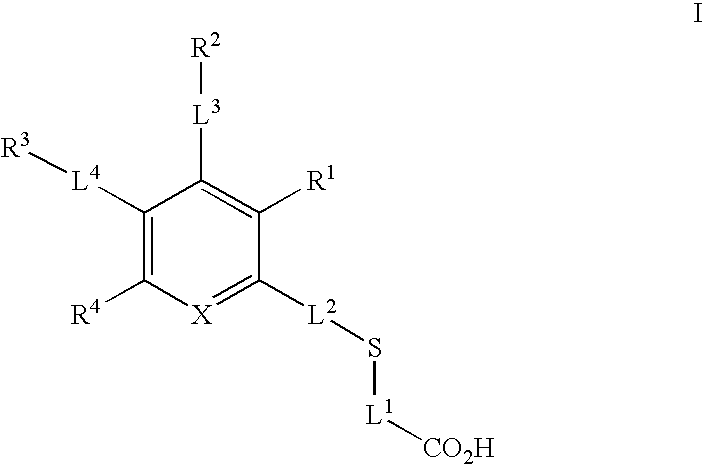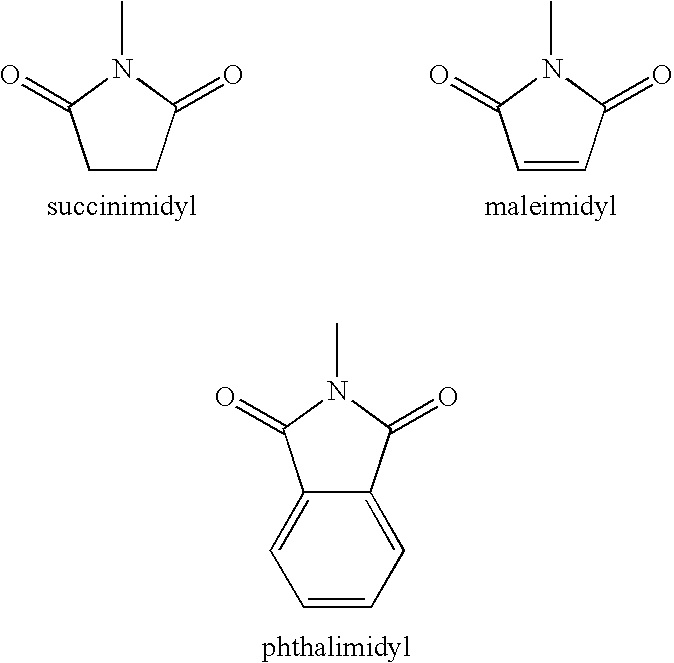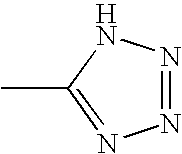Glyoxalase inhibitors
a technology of glycosalase and inhibitors, applied in the field of glycosalase inhibitors, can solve problems such as general cell toxicity
- Summary
- Abstract
- Description
- Claims
- Application Information
AI Technical Summary
Benefits of technology
Problems solved by technology
Method used
Image
Examples
example 1
Formation of {4-[(Benzoyl-hydroxy-amino)-methyl]-phenylsulfanyl}-phenyl-acetic acid ethyl ester (iv)
Step 1—(4-Hydroxymethyl-phenylsulfanyl)-phenyl-acetic acid ethyl ester (i)
[0250]
[0251] 4-Mercaptobenzyl alcohol (0.582 g, 0.0042 mol), ethyl alpha bromophenyl acetate (0.727 ml, 0.0042 mol) and potassium carbonate (0.86 g, 0.0062 mol, 1.5 eq) were refluxed in acetone (25 ml) for 12 h. The crude material was purified by flash column chromatography (Ethyl acetate / hexane) to give the product i as a yellow oil (0.79 g, 63%).
Step 2—(4-Methylaminomethyl-phenylsulfanyl)-phenyl-acetic acid ethyl ester (ii)
[0252]
[0253] Trifluoroacetic anhydride (0.4 ml, 0.002 mol) was added to a solution of i (0.65 g, 0.002 mol) in dichloromethane at 0° C. under nitrogen. After 5 min lutidine (0.29 ml, 0.0024 mol) was added and the solution stirred for a further 5 min. O-Tetrahydro-2H-pyran-2-yl-hydroxylamine (0.5 g, 0.004 mol, 2 eq) was added and the cooling removed. The reaction was stirred at room tempe...
example 2
Formation of {4-[(Benzoyl-hydroxy-amino)-methyl]-phenylsulfanyl)-phenyl-acetic acid (A)
[0258]
[0259] To a solution of iv (0.079 g, 0.19 mmol) in THF / water (6 ml / 2 ml) was added sodium hydroxide (0.47 mmol, 2.5 eq). The reaction was stirred at room temperature for 16 h. The solution was neutralized with 1M HCl (0.11 ml) and the solvent removed in vacuo. The crude material was purified by prep HPLC to yield the required product (A) (4.1 mg, 6%).
[0260] 1H NMR (400 MHz, MeOD-d4) δ: 7.7-7.1 (14H, Ar), 4.9 (1H, s), 4.75 (2H, m, CH2), m / z [ES] 394 [M+H]+
example 3
Formation of 2-{4-[(Benzoyl-hydroxy-amino)-methyl]-phenylsulfanylmethyl}-benzoic acid methyl ester
Step 1—2-Bromomethyl-benzoic acid methyl ester
[0261]
[0262] To a solution of methyl 2-methylbenzoate (5 g, 0.033 mol) in carbon tetrachloride (85 ml) was added n-bromosuccinimide (5.93 g, 0.033 mol) and benzoyl peroxide (0.22 g, 0.9 mol). The reaction was refluxed for 4 hr. The reaction was cooled to room temperature. The white precipitate was filtered and the solvent removed. The oil was dissolved in Et2O and cooled to −78° C. The product precipitated and collected yielding v (5.86 g, 77%).
Step 2—2-(4-Hydroxymethyl-phenylsulfanylmethyl)-benzoic acid methyl ester
[0263]
[0264] 4-Mercaptobenzyl alcohol (0.579 g, 0.0041 mol), methyl 2-bromomethyl benzoate (v) (0.946, 0.0041 mol) and potassium carbonate (0.85 g, 0.0062 mol, 1.5 eq) were refluxed in acetone (25 ml) for 12 h. The crude material was purified by flash column chromatography (ethyl acetate / hexane) to give the product vi as a co...
PUM
 Login to View More
Login to View More Abstract
Description
Claims
Application Information
 Login to View More
Login to View More - R&D
- Intellectual Property
- Life Sciences
- Materials
- Tech Scout
- Unparalleled Data Quality
- Higher Quality Content
- 60% Fewer Hallucinations
Browse by: Latest US Patents, China's latest patents, Technical Efficacy Thesaurus, Application Domain, Technology Topic, Popular Technical Reports.
© 2025 PatSnap. All rights reserved.Legal|Privacy policy|Modern Slavery Act Transparency Statement|Sitemap|About US| Contact US: help@patsnap.com



